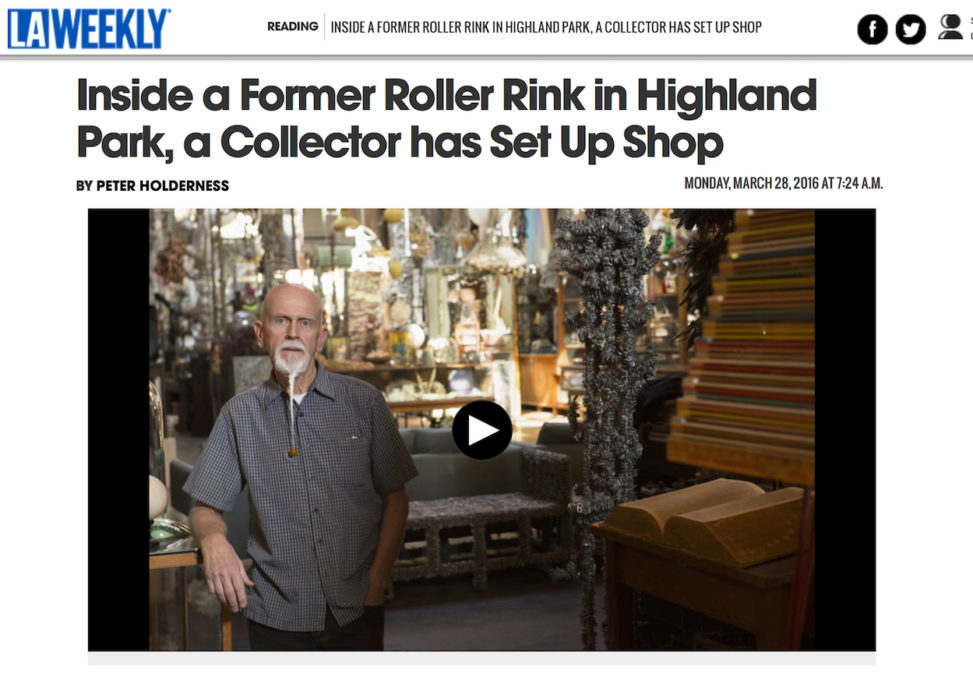LA Weekly March 28, 2016
By Peter Holderness
“I’ve hand resourced, found, collected, manipulated and played with each one of these things,” Clare Graham says, looking over his collection of flea-market treasures transformed into whimsical, meaningful totems, all packed into the former Highland Park roller rink he calls MorYork Gallery. “I guess by looking around you get a pretty good idea of my own history.”
Graham was one of Disney’s pioneering art directors, serving the empire of the Mouse for more than 25 years and traveling — and collecting — all over the world.
Originally built in 1933 as a Safeway supermarket, the 7,000-square-foot space later became a roller skating rink (Skate City), a place to race slot cars (Race City) and a jewelry shop (J.J. Jewelcraft), before being left vacant. When Graham and his partner, Bob Breen, bought the place in 1986, it was full of roller skates, tracks, jewelry, geodes and other detritus of its history. The incinerator stack still visible at the back of the building was used by Safeway to burn its trash.
It took a few years to lay out the space out for storage, work space and gallery space.
“Now we find that stuff comes and goes so quickly that the space morphs continually,” Graham says. “There are families of things grouped together because objects speak to each other and have a certain resonance.”
Every weekend and on some weekdays, Graham and Breen head to flea markets, garage sales, estate sales and thrift stores; Graham says he was at the first Rose Bowl flea market and has missed very few since then. Graham might buy and collect a particular item for years — rosary beads, pet collars, cocktail stirrers — while Bob organizes and labels the quarry into boxes held on shelves at the MorYork space. At some point inspiration strikes and Graham gets to work.
“I feel responsible for all these materials I collect — nurturing, protecting and keeping them available. Once I make something out of it, the object has its own life and is free to go off to something else; to be sold, to be bought or be given. Most likely given,” Graham says. With a smile, he adds, “I don’t have a great sales record.”
MorYork was a cornerstone of the NELA arts scene, hosting monthly shows and events, though the space no longer participates in the art walk. Graham finds that gentrification of the neighborhood has made impermeable layers, where longtime residents don’t mix with new neighbors. Graham and Breen wanted to open their space “to any creative force within this community,” and today they host music, dance and visual-arts performances, plus open studio sessions every week.
Graham stores remains from some of these performances in his voluminous cabinets, drawers and cases.
“A young woman from Art Center covered the entire floor with over 10,000 eggshells,” Graham recalls. “She colored the insides with different colors and laid them out in a very specific pattern. When the front door opened, people couldn’t avoid walking on the giant carpet of eggshells. As the shells started breaking, the color was revealed and a giant pattern emerged. These are remnants of that event, which was one time only, then it got swept up and put away.”
Clare has collected color wheels, orphaned taxidermy, collapsible yardsticks, even a tractor trailer full of buttons. For a 2014 show at the Craft and Folk Art Museum, he built 13 identical cabinets, using thousands of letter tiles from Scrabble and Anagram sets to give them differentiated skins and collaging their innards with poetry, prose and other inspirations.
“I’m forever looking for an undetermined thing that gives me an aesthetic epiphany,” he says. “Something that strikes a note, that allows me to forecast what could become of this stuff. There’s an unwritten, unknowable history that each of these objects have that I find really important.”
“Bones and skulls I like a great deal,” Graham says, before focussing on an arrangement of well-worn dog tags that he says emanates power through patina and more. “It’s got this whole other life. Most objects do, if we could only plumb them and understand what they mean.”
HABITAT is a feature that offers a glimpse inside some of the coolest spaces in Los Angeles, from homes to workspaces to galleries. Want to show off a space or nominate someone who should? Email gstuart@laweekly.com with HABITAT in the subject line.

Leave a Reply